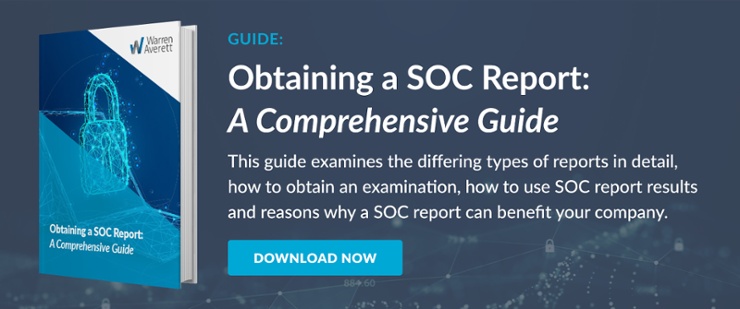An Overview of the SOC Report Types (And How to Know Which One You Need)

What are the different System and Organization Controls (SOC) report types? Which does your organization need?
Getting a grasp on the differences of the reports and their types will help you better understand precisely what your customers are asking for if they request a specific report type from you.
It will also clarify the level of commitment you’re making to have the assessment completed and the report created.
To understand the SOC report types, it’s important to first become familiar with the different SOC reports and what their functions are.
There are a variety of SOC reports, and each has a specific purpose:
- SOC for Service Organizations
- SOC 1®: The SOC 1 is focused on financial controls, primarily intended to meet audit requirements for the user entity.
- SOC 2®: Most common for vendors and software providers who may have access to confidential or sensitive information, a SOC 2 looks at the trust services criteria defined by the AICPA.
- SOC 3®: The SOC 3 is an add-on report to the SOC 2. It’s shorter and more high level than the SOC 2 report.
- SOC for Cybersecurity: The SOC for Cybersecurity is an assessment of an entire organization’s cybersecurity risk management.
- SOC for Supply Chain: Service organizations that are a part of a user entity’s supply chain may be evaluated with a SOC for Supply Chain to show security, efficiency and adherence to regulations.

What can further complicate a company’s understanding of SOC reporting is that, in addition to the variety of reports listed above, the SOC 1 and SOC 2 reports also have two report types: Type 1 and Type 2. Since SOC 1 and SOC 2 are the most highly demanded reports, we’ll focus on a more detailed review of the types associated with them.
Report Types: SOC 1
A SOC 1 report, previously referred to as a SAS70 or an SSAE 16, is focused on controls at service organizations that can have an impact on a user entity’s financial reporting. There are two types of SOC 1 reports.
SOC 1 Type 1 Report
With a Type I report for SOC 1, an organization’s management asserts which internal controls exist within the organization regarding financial reporting. Those assertions are reviewed by a qualified CPA and evaluated for the suitability of the design of controls and fair presentation of the system description (controls narrative) as of a specified date in regard to the services provided.
SOC 1 Type 2 Report
A Type 2 report differs in scope and testing. Type 2 extends past the assertions of just the system description and design of controls to include testing of those controls. The emphasis, clearly, shifts from the existence of the controls to their operating effectiveness over a period of time—typically 6 to 12 months.
Report Types: SOC 2
SOC 2 reports have a much larger potential user audience than a SOC 1 report. Because they revolve around security and processing of data, among other elements, there is a wider range of service organizations and user entities that a SOC 2 report applies to.
SOC 2 Type 1 Report
A SOC 2 Type 1 report differs from the SOC 1 Type 1 report in focus but is similar in scope. Again, the Type 1 report is an attestation examination of a service organization’s suitability of design of its internal controls relevant to the trust services criteria as of a specified date. The system description for SOC 2 reports also must comply with certain standards as separately outlined by the AICPA in the DC Section 200 Description Criteria.
SOC 2 Type 2 Report
Again, the SOC 2 Type 2 report diverges from the SOC 1 in subject matter but mirrors it in scope. Instead of being an examination limited to a specific date, the Type 2 report looks at the internal controls and includes the testing of those controls over a period of time—usually 6 to 12 months.

How Do You Know Which SOC Report Type You Need?
There is no question that a Type 2 report for either the SOC 1 or the SOC 2 is more involved, more time-intensive and ultimately more costly than a Type 1. It may be that your customer has requested a Type 2 report. However, there are many other reasons to choose a Type 2 over a Type 1, and the additional cost may save you money in the long run.
When providing a potential client with a SOC 1 or SOC 2 report, a Type 1 will show that you’ve taken the steps necessary to validate your controls. This is certainly a differentiator for your business. However, for some industries, a Type 1 report is merely the cost of getting a seat at the table and may not, actually, separate you from your competitors.
In these cases, the extra time, attention and validation that comes out of a Type 2 report could possibly be what puts your organization above others. Having tested your controls over a period of time, it’s crystal clear to potential clients that you have well-designed controls in place that have been implemented and are operating effectively.
A Type 2 report can also be an internal asset. A Type 1 report will evaluate your controls, but it’s the implementation and consistent performance of those controls that is key. With a Type 2 report, your business will have a roadmap of any improvements that might be needed to tighten how those controls are applied.
In essence, a Type 2 report takes the blinders off of your organization, shifting you from asserting the existence of your controls to finding and fixing problems with their application. The extra cost of the Type 2 report could save you time, by having the report readily available instead of having to complete lengthy, detailed vendor questionnaires, and dollars, by possibly identifying any areas of risk that could lead to costly incidents or data breaches.
Learn More about the SOC Report Types and Which Your Company May Need
Choosing the right SOC report, and the right SOC report type, can lead to more clients, better security and increased trust in your organization.
Each report type takes an investment of time, of course, with a Type 2 report requiring a longer and more regular commitment. However, waiting until you are asked for a SOC 1 or SOC 2 report may put you at a disadvantage. You may not have weeks or months to have a report produced before a client or a prospective client goes elsewhere for services.
If you’re unsure which SOC report type is right for you, contact Warren Averett.

